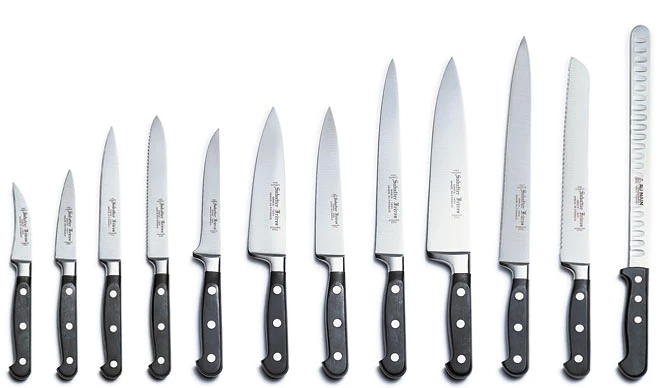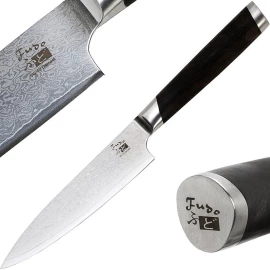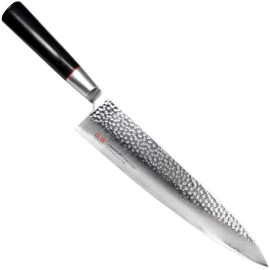Kitchen knives

Contents
Types of kitchen knives
Cleaver – heavy, usually rectangular bladed knife with very tough edge. It is made for carving of meat while chopping through thin bones and therefore it is used by butchers too. The solid blade also allows you to crush food with its side. Its surface is bigger and it is more resistant too so it will not crack after several applications like some other knives could.
Boning knife – middle sized knife commonly featured with finger guard for easier manipulation. Its blade is usually 12-17 cm long and it is narrow and well pointed at its end. The knives can differ by their elasticity. The stiffer ones are better for work with beef or pork, the more flexible ones are rather designed for poultry and fish
Fillet knife – knife with very thin and flexible blade (length of blade: 15-28 cm) most suitable for cutting fish meat to slices
Steak knife – We do not usually bring sharp knives to the table today, except the steak knife. It is often featured with serrated blade which can easily cut both, either raw or cooked meat.
Smoked meat/ham knife – usually long and narrow with thin blade. Its advantage is an ability to cut really thin slices.
Cheese knife – there are many kinds of cheese and basically each one can have own kind of knife. Probably most common is soft cheese knife recognizable by its forked end and by holes in the blade which prevents sticking of cheese to the blade.
Vegetable knife – a lot of fruits and vegetables contain various acids which may be aggressive to steel blade and furthermore cutting with steel causes loss of vitamins. Therefore the best vegetable knives are the ceramic ones. The blade can sometimes be notched or have forked end (similar as cheese knives). The ceramic blades are very hard so they stay sharp for a notably long time.
Herb/spice knife – special knife with curved blade. Either it has two handles (one at each end) which give it a shape of a horseshoe or just one handle connecting both ends so it resembles letter D. Some herb knives have two parallel blades instead of one which make them more stable.
Bread knife – featured by smart serrated blade it is ideal for cutting bread or other soft bakery products without crushing it and with no difficulties in both directions. Unfortunately, the blade was invented exactly for its purpose and does not have any other application.
Butter knife – Blunt knife which blade is often rounded so it resembles common table knife very much. There are also sharp-pointed sabre shaped variants.
Peeling knife – it can be recognized by short curved blade which is best utilized by peeling potatoes, vegetables etc.
Confectionery knife – special kind of utensil with long blade which is rounded at its end. The edge can be notched. These knives find their use in cutting the cakes or icing application.
Bartender knife – there are various types of bartender knives. They are small and many of them are fork ended. The blade is slightly wavy to protect fine materials to work with. Bartenders can also appreciate combinations of knife and opener or corkscrew etc.
Universal kitchen knife – knives with such combinations of attributes which allows universal usage.
Material
Surely the most commonly used material in stainless steel. Stainless steel blades are hard and firm and easy to sharpen. Please note they are various kinds of steel and processing methods (e.g. damask steel) and they can be improved by some features (e.g. by non-stick surface) which results in different levels of quality, usability, durability and so on.
If you are looking for extreme sharpness, then carbon steel is a good choice. Its hardness is based on percentage of carbon, but it is not so high, so more frequent sharpening is required and of course they can rust quickly if you do not keep them dry. However, they provide much more precise cutting service.
No doubt ceramic knives are suitable for working with fruits or vegetable. Apart from being extremely hard, they are light, have non stick surface, do not rust and they resist to chemicals. Their weakness is fragility - they can crack easily after falling on the floor. Therefore they are not suitable for dishwasher. You also cannot sharpen them with whetstones as the steel ones and you have to visit specialized service.
There are other less common materials like titanium (light, very flexible and resistant, but very expensive) or plastic (sharpness is very limited).
How to choose the right knife
Good source of helpful advices about various models of knives offered in the market can be the reviews from actual customers. They are easily accessible usually right on seller’s websites. You can also look at personal sites of knives enthusiast or thematic forums and find some discussions or recommendations there. Some brands have built their name by making high quality knives and you can practically always rely on their products, but they are certainly more expensive. The price of course should not be the only deciding factor.
Manipulation with knife should be easy and comfortable and it should fit in your hand well and be balanced right. If possible, you can come to a shop which sells the knife you are looking for and check these attributes for yourself or try some other similar ones.
Kitchen knives should be bevelled on both sides (there are some exceptions for Asian sushi knives or special cleavers which are one side bevelled). Some knives need to have finger guard between the blade and the handle. Especially the ones which we apply force on. For example, be sure your boning knife has finger guard.
Considerable issue is also material used on handle. Steel handle is most durable, but can slip in wet hands. Therefore some of them may have ridges and bumps. There is also alternative of rubber handle. Wooden handle also offers better grip and looks nice, but needs a special care. It cannot be exposed to water for a long time. Do not put it in dishwasher, just rinse it and then dry it immediately. Eventually there are plastic handles which does not need so much care but after some time they can become fragile and crack.
How to look after kitchen knife
It is not very recommended to wash kitchen knives in dishwasher (especially the ones with wooden handle which would ruin them) unless they are Teflon.
Keep your knives sharp. The work with them will be more pleasant and safer then. See the instructions how to do it.
Prevent them from becoming blunt by correct storing which means separately from other knives – into a knife rack or on magnetic desk and so on.




Comments